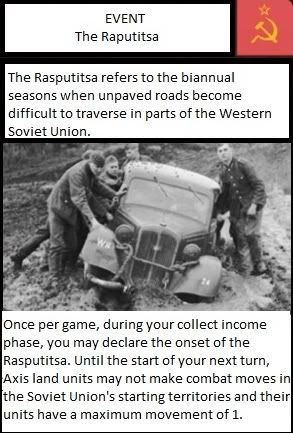Here are revised suggestions for cards for France, China, and Anzacs.
France
Free France: After Paris has fallen, France may establish a new capital in French Equitorial Africa. Place a free Minor industrial complex there. France continues gaining money as normal. This card must be played at the start of the game. It is incompatible with the Franco-British Union card.
Franco-British Union: All French Units and territories immediately become British and, if Paris is liberated, then it returns to British control. A Germany capture of Paris conquers the starting French income. This card must be played at the start of the game and is incompatible with the Free France card. All remaining French cards are discarded.
Lend Lease France: If the United States has played the lend lease card then France may play this card to gain the warbonds tech.
Jean de Lattre de Tassigny: Infantry cost 1 ipc less to purchase.
Henri Giraud: Artillery attacks and defends at a 3 during the first cycle of combat.
Maurice Gamelin: Infantry defend at a 3 during the first cycle of combat.
CHINA
Vinegar Joe: Chinese infantry defending a Burma road province hit at a three or less during the first cycle of combat.
The United Front: Once per game the Chinese may declare that the United Front is in effect. For that turn only an influx of communist guerilla fighters reduces the cost of Chinese infantry by 1 ipc.
Operation Zet : China may build fighters as long as it has a land link between Szechwan and the USSR. The max number of fighters that China may field at any given time is 3. Furthermore, Soviet and Japanese forces may clash in the Chinese interior (ie provinces that do not border the Soviet Union) without a declaration of war.
Lend Lease China: If the United States has played the lend lease card then China may play this card to gain the warbonds tech.
Eight Route Army: If Chinese Infantry survive at least one round of combat when defending against a Japanese attack, then these units may choose to melt away into the countryside. For all intents and purposes treat this like when submarines submerge. The Japanese occupy the province and, on the next Chinese turn, the Chinese units are back in play. The Chinese player must either have these units attack the province or move on to another province. These units may chose to attack provinces behind the Japanese lines, causing Chaos in the rear.
Unforgiving Wilderness: Axis tanks may not blitz in China, they may still move 2 spaces normally. Only two axis aircraft can land in a Chinese territory that is worth only 1 IPC. This card may only be played at the start of the game.
ANZACS
ABDA Command: Annex all unoccupied Dutch possessions in the Pacific once at War with Japan. This card may only be played at the beginning of the game.
Cockatoo Island Shipyard: Gain the Improved Shipyards Tech.
Coastwatchers : Once per game, when Japan finishes its combat move phase but before its conduct combat phase, you may make one special move. You may move any number of your units from an adjacent space into any one friendly space being attacked by Japan. Alternatively, you may move any number of your units from a space being attacked by Japan into an adjacent friendly space, but you must leave at least one unit behind. This special move otherwise follows the rules for a noncombat move. If your units survive, they remain in the space to which they were moved.
Australian Commandos: Before the ANZAC combat phase of every turn, the ANZAC player may attempt to sabotage a Japanese air or naval base. Pay 3 ipcs and pick a single Japanese naval or Airbase. Roll 1d6 damage to the facility. You may only target facilities that are 4 or less spaces away from allied territory.
Lend Lease Australia: If the United States has played the lend lease card then the ANZACs may play this card to gain the warbonds tech.






